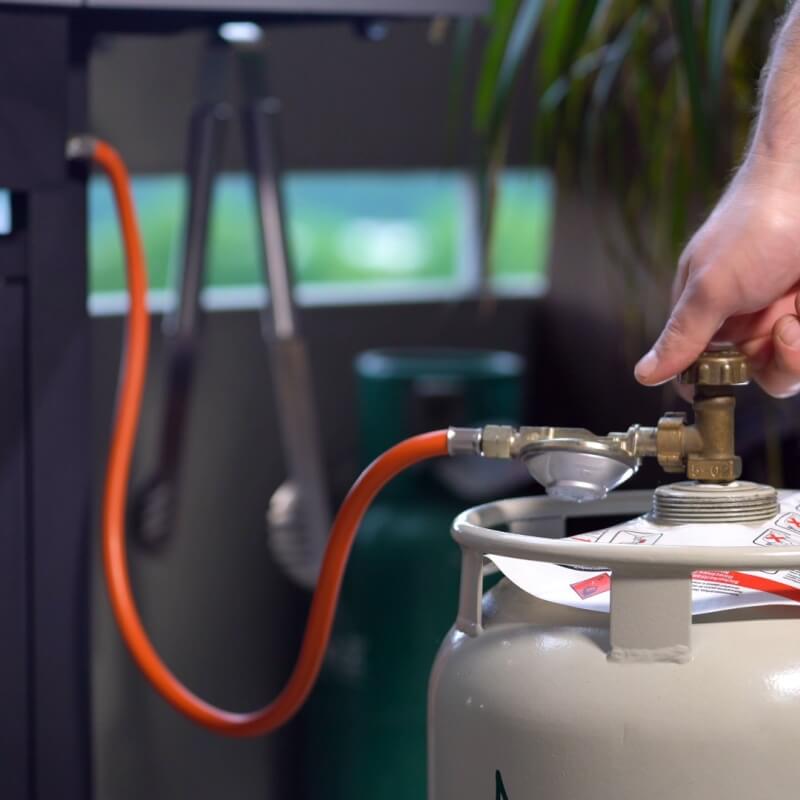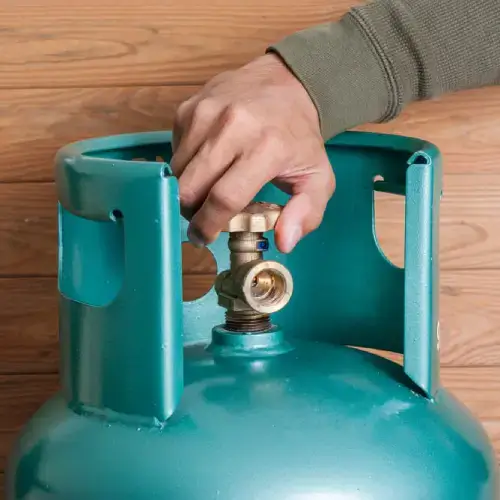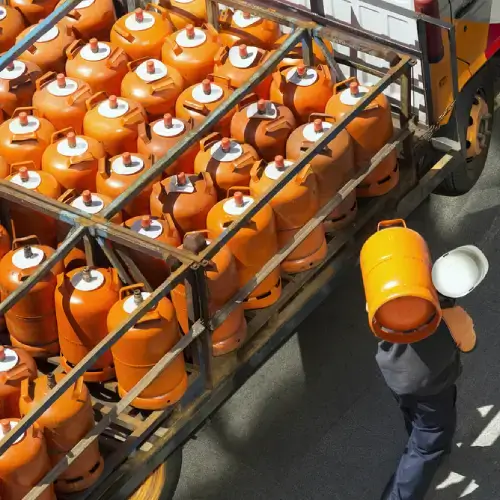Home / Compare Electricity &… / Your guide to LPG

Key takeaways
If you use gas for cooking, heating your home or to power your hot water system, and you don’t have natural gas connected to your property, there’s a good chance that it’s LPG. Read on to find out more about this gas, why it’s used and how it’s different from other gases.
- Liquid Petroleum Gas (LPG or LP gas) is a popular way of powering gas appliances.
- LPG comes in gas cylinders and doesn’t require your home to be connected to the natural gas pipeline.
- Different appliances may require different size gas cylinders; this will affect the upfront cost.
- Before buying LPG, make sure your appliances are fitted correctly; appliances fitted for natural gas are not interchangeable and will need to be professionally refitted.
Understanding LPG
What is LPG?

Liquefied Petroleum Gas (LPG or LP gas) is a flammable gas produced through crude oil refining and processing natural gas. It’s used primarily in homes and businesses as an energy source for heating, powering hot water systems and cooking food.
You can also use it to fuel barbecues, cars and even forklifts. While LPG is usually a mixture of propane and butane hydrocarbon gases, it’s primarily made up of propane in Australia.1
Why do people use LPG?
Bottled gas is used by 14% of Australian homes, with the majority of them relying on LPG.2 Many people opt for LPG because it’s clean, cost-effective, efficient and portable compared to other types of gases. While not a renewable energy source, it isn’t as damaging as crude oils, such as diesel.
Using LPG and natural gas can reduce carbon dioxide emissions and greenhouse gases. In fact, carbon emissions by around 25% and all but eliminate several dangerous chemicals.3 LPG also burns hotter than other gases, meaning it could be more efficient to use as a fuel source. It’s also quite portable and easy to transport since it’s available for purchase in gas bottles of various sizes.
Propane vs LPG
Propane gas and LPG are fundamentally the same types of gas, although LPG may contain other hydrocarbon gases, such as butane.1 When pressurised, both propane gas and LPG liquidise and can be used as a source of fuel or heating. Both are commonly stored in gas cylinders or bottles.4
Natural gas vs LPG
The main difference between LPG and natural gas (which can be a mixture of many different types of gases) is how they’re distributed: Natural gas is accessible through pipelines, and LPG is available via cylinders or gas bottles.5 Even though both LPG and natural gas are used widely across Australia for similar purposes, they’re also made up of different gases. LPG is essentially propane, while natural gas contains mainly methane.6
Where you live in Australia usually determines whether you have access to natural gas. If you require gas as an energy source but can’t access natural gas from the mains supply, you’ll typically need to order LPG. Keep in mind that while many household appliances can use either LPG or natural gas, gas retailers usually won’t let you use both. In these cases, ensure your appliance is fitted with the right connections for the type of gas you’re using.
What are the LPG gas cylinder sizes?
There are various sizes of LPG gas cylinders available, but the size you’ll require may depend on how you use the gas. Most households will require a 45kg gas bottle at a minimum. However, bigger sizes are available, including 90kg, 190kg or 210kg.
Cylinders over 45kg will need to be filled on-site by professionals or exchanged. Smaller cylinders and gas bottles (like 4kg and 9kg bottles used for barbecues or outdoor heating) can be exchanged.
Important to know
What is LPG used for around the home?

LPG can have many uses around the home and fuels an array of gas appliances, including:
- Ovens
- Gas stoves
- BBQs
- Hot water systems
- Heaters
Who are Australia’s LPG suppliers?
There are several main LPG suppliers across Australia, including:
- Elgas
- Origin
- Supagas
- Kleenheat.
There may also be smaller, local suppliers in your area.
How much does LPG cost?
Various factors can impact the amount you pay for LPG, so there’s no single answer. As well as differing costs between retailers and gas bottle sizes, you may incur:
- Delivery fees. Suppliers may set prices to fill or replace your bottles.
- Rental fees. If you use exchange services, you could be charged a rental fee for the cylinders.
- Usage fees. You’ll usually pay more if you consume higher volumes of LPG. The price of a 90kg gas bottle for your home will be more than a 45kg bottle.
How to manage LPG gas cylinders
How do I fill my gas cylinder when it’s empty?
You generally have two options for refilling your LPG gas bottles. Suppliers can fill the cylinders on-site via an automatic tanker delivery if you have 90kg bottles (or heavier). They can also arrange a gas bottle exchange if you have 45kg bottles, where empty cylinders are replaced with full ones.
Both options can be organised through your supplier and are designed to keep LPG hooked up to your house. Many households choose to have multiple cylinders installed at one time; you use the other cylinder when one runs out, and the empty one is replaced.
Smaller LPG bottles are usually used for camping, barbeques or small gas heaters. Gas bottles that are 9kg or less can typically be replaced or refilled at most service stations.
Can I transport my gas bottles and cylinders myself?
You’ll usually need to have your LPG bottles delivered by an authorised supplier. If you’re transporting them in a car, the capacity must not exceed 9kg and there can’t be more than two cylinders at a time. This usually applies to smaller bottles used to power appliances such as barbecues.
As most home gas bottles exceed this weight, you’ll need to organise LPG delivery through an authorised supplier.
Is it safe to use a gas cylinder that’s rusted?
Generally, it’s not safe to use an LPG cylinder that’s rusted or damaged in any way. If damage or rusting occurs, discontinue use until professionals can inspect it at a gas cylinder test station.4 If you’re unsure if your LPG cylinder is damaged or need advice, contact your gas retailer for assistance or a replacement gas bottle.
If I have two LPG cylinders, how do I change between the empty and full one?
If one of your LPG cylinders is empty, switching to the full one is a straightforward process. Your cylinders will either be equipped with a manual or automatic changeover system. With automatic systems, your gas supply will, as their name suggests, automatically switch from the empty cylinder to the full one.
For manual changeover systems, always refer to your supplier for instructions on how to change bottles and the safety steps to follow. Some gas bottles may have an indicator that notifies you (usually by a colour-coded message on the bottle) when it needs to be replaced.
Where should LPG cylinders be stored?
All LPG cylinders should be stored upright and outside in a ventilated location. The cylinders shouldn’t be exposed to excess heat, as this could cause leaks or explosions. Generally, cylinders are installed in a safely designated location near your home and shouldn’t be moved or tampered with without professional guidance.
Any installations have to be done in line with your state’s regulations, which is why it should only be done by licensed gas fitters.
Can I fill my LPG cylinder using an Autogas dispenser?
No, you can’t fill your LPG cylinder using an Autogas dispenser, and it’s illegal to do so in Australia.1 As well as being extremely dangerous, appliances in Australia only operate with LPG that contains mainly propane. Autogas (or automotive LPG) dispensers primarily contain butane.
Meet our energy expert, Meredith O’Brien
As the Head of Energy at Compare the Market, Meredith O’Brien believes in educating Australian customers about the everchanging gas and electricity market so they can adjust their energy usage habits and get the most out of their energy plans.
Meredith has six years within the energy industry, following 15 years of experience in financial services and is currently studying a Master of Business Administration. Meredith is a dedicated customer advocate who is passionate about empowering Australians to find the right products to suit their needs by removing the confusion from comparing.
Find out more about energy
1 Parliament of Australia. Liquid Petroleum Gas. Accessed May 2022.
2 Climate Council of Australia. Kicking the gas habit: how gas is harming our health. Published 2021. Accessed May 2022.
3 Gas Energy Australia. Cleaner, Reliable Australian Fuels – 2020-21 Pre-Budget Submission. Accessed May 2022.
4 Government of South Australia. LPG cylinders and fittings. Last updated June 2021. Accessed May 2022.
5 Queensland Government. Compare and choose gas retailers. Accessed May 2022.
6 US Energy Information Administration. Natural gas explained. Accessed May 2022.



